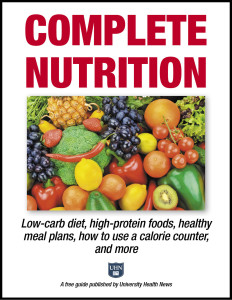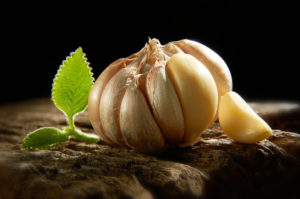Gastritis Diet: Foods That Heal and Foods to Avoid
Gastritis is an inflammation or irritation of the lining of the stomach. It can occur suddenly (acute gastritis), lasting one to three days, or it can be chronic, lasting several days to weeks. Can a gastritis diet help relieve symptoms? Fortunately, it can, as we’ll find out below.
First, a word on gastritis symptoms. Stomach inflammation, discomfort, and gastritis pain may include the following:
- Heartburn/indigestion (a burning feeling in the stomach/chest)
- Nausea or vomiting (sometimes vomiting blood or “coffee”-like material)
- Loss of appetite
- Abdominal pain and/or bloating
- Hiccups
- Black, tarry stools
Eat Right, Starting Now!
Download this expert FREE guide, Complete Nutrition: Low-carb diet, high-protein foods, healthy meal plans, how to use a calorie counter, and more.
Create healthy meal plans and discover the Superfoods that can transform your plate into a passport to better health.
Conventional Gastritis Treatment… and a Gastritis Diet
The conventional gastritis treatment involves taking antacids or other drugs to reduce stomach acid. While these drugs work quickly to ease symptoms, chronic use of these medications can lead to severe problems, such as osteoporosis or a condition called hypchlorhydria (low stomach acid).
Popping antacid pills may mask your gastritis symptoms, but they likely won’t provide a gastritis cure. Instead, adopt a gastritis diet, which can correct the root causes of gastritis while helping to you heal your gut naturally. (See sidebar below: “4 Main Causes of Gastritis.”)
Home remedies for gastritis include eating a combination of healthy foods while simultaneously avoiding the food “culprits” on a daily basis. This is the key for permanent treatment for gastritis.
Gastritis Diet Tip #1
Make sure your diet regularly includes foods that kill Helicobacter pylori (H. pylori) bacteria (for more, see “What You Should Know” sidebar below). Go-to selections include these choices:
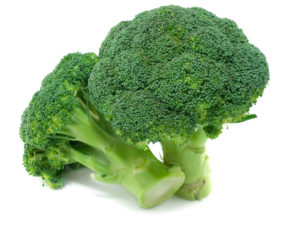
Broccoli and (below) garlic are reliable gastritis diet choices for their ability to kill H. pylori bacteria. [Photo: © Motorolka | Dreamstime.com]
- Broccoli. A nutrient in broccoli called sulphoraphane has been proven effective by medical research to kill H. pylori bacteria in the stomach lining. It even works at killing strains of H. pylori that have become resistant to antibiotic drugs.[2] And, broccoli sprouts contain 20 to 50 times more sulphoraphane than the mature plant. If you don’t like the taste of broccoli, you can purchase broccoli or sulphoraphane supplements online or at your local health food store. Since 50 percent of the world’s population has H. pylori—even though they may not know it—eating broccoli several times per week or taking supplements is recommended for everyone.
- Garlic. Garlic is a broad-spectrum antimicrobial and antifungal agent, and H. pylori bacteria are highly sensitive to it. However, some people with chronic heartburn do not react well to garlic. If this applies to you, try eating small amounts of garlic first (or take garlic capsules) and gradually increase the amount to tolerance.[3]
Gastritis Diet Tip #2
Don’t overlook probiotics. Probiotics such as the Lactobacillus and Bifidobacterium species are beneficial bacteria that colonize the soft lining of the intestinal tract and thus heal the digestive system. Taking probiotics can help increase the gut’s ability to absorb and digest nutrients. For people who have gastritis and vitamin B12 deficiency, eating foods with probiotics (or taking probiotic supplements) with B vitamins can help tremendously. Which foods contain probiotics? Organic yogurt, kefir, sauerkraut, and sourdough bread are popular and accessible choices.
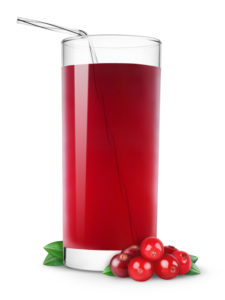
Probiotic-rich sources include beet juice, carrot juice, and (pictured) cranberry juice. [Photo: © Anna Kucherova | Dreamstime.com]
Gastritis Diet Tip #3
Eat foods that reverse damage from medication use and ease gastritis symptoms. Again, probiotic-rich foods are most beneficial in reversing gut damage. But in addition to probiotics, these particular items have been found to both heal the stomach and ease gastritis symptoms of nausea, stomach pain, burning, bloating, and heartburn:
- Ginger
- Apple cider vinegar
- Turmeric
- Oregano
- Cranberry juice
- Pineapple (bromelain)
- Beet juice and/or carrot juice
- Green tea
Also, you’ll want to eat foods high in vitamin A: liver, carrots, greens, spinach, asparagus, sweet potatoes, peaches, and apricots. Vitamin A is essential for the healthy function of mucous membranes and tissue repair.
FYI
RESOURCES: GASTRITIS, HEARTBURN, AND ACIDIC DIET ISSUES
These University Health News posts offer more information on the effects of an acidic diet and how to treat gastritis:
Gastritis Diet Tip #4
Avoid foods and beverages that exacerbate your gastritis symptoms. Many people who suffer from gastritis know exactly which foods items exacerbate their symptoms, whether it’s coffee or chocolate, hot peppers or pasta. If you don’t know which foods trigger your gastritis, then you need to find out.
It’s easy to do—simply create a food diary. For two to four weeks, write down everything you eat or drink and note the exact date/time you eat it. Simultaneously, write down any time you experience gastritis symptoms.
After your food diary has been completed, notice correlations between your food consumption and the symptoms you experienced. For example, do you develop nausea or heartburn an hour after eating pizza? Or, do you experience bloating and cramping the day after eating breads or sweets? Once you figure out your specific gastritis triggers, you’ll know exactly which foods or beverages you should avoid.
Gastritis Diet Tip #5
Make sure your diet changes are permanent, not short-lived. Permanent gastritis relief and prevention will involve changing your lifestyle. While it’s not easy, with hard work, it can be accomplished! On a daily basis, try following a gastritis diet that respects the integrity of the stomach lining. That is, eat whole foods with plenty of protein, natural fats, and fruits and vegetables, all of which provide your body with the needed nutrients to support healing.
Gastritis Diet Tip #6
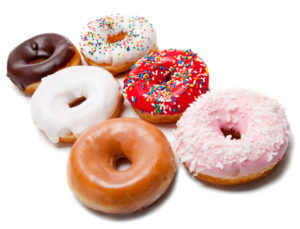
Don’t do it. Sweets can wreak havoc with gastritis. Diet choices are key to relieving or avoiding gastritis symptoms.
Finally, avoid the “food culprits” that can damage both your gut and your immune system. Keep these selections off of your menu:
- Dairy (other than organic yogurt)
- Soy
- Corn
- Grains
- Gluten
- Potatoes
- Processed foods
- Sweets
- Sodas
- Excessive coffee drinks
- Energy drinks
- Foods with trans fats
WHAT YOU SHOULD KNOW
4 MAIN CAUSES OF GASTRITIS
What causes gastritis? There are several reasons why a person could develop the condition—chronic stress, for example, or an autoimmune disorder such as HIV, fungal infections, acid reflux disease, and more. But typically, gastritis symptoms start with one of four primary causes.
- Helicobacter pylori (H. pylori) bacteria. Up to 50 percent of the world’s population is infected with this bacteria, although most people do not experience symptoms or even know they have it.[1] H. pylori can break down the lining of the stomach, causing gastritis and stomach ulcers.
- Conditions related to vitamin B12 deficiency. Vitamin B12 deficiency results when the gastrointestinal tract does not properly absorb vitamin B12, most likely due to chronic inflammation—gastritis. Therefore, the conditions that cause gastritis are the same as those that cause vitamin B12 deficiency: celiac disease (gluten sensitivity), Crohn’s disease, recent stomach surgery, recent infection, poor nutrition, thyroid disease, or pernicious anemia, a form of anemia that occurs when the stomach lacks a naturally-occurring substance called intrinsic factor needed to properly digest vitamin B12. (See our post “The Top B12 Foods for Every Diet.”)
- Medication use. Sometimes, gastritis symptoms stem from taking medications that cause stomach problems or even stomach bleeding: aspirin, NSAIDs (ibuprofen or naproxen), prednisone, chemotherapy drugs, or others.
- Acidic drinks, spicy foods, and other food culprits. Drinks such as coffee, alcohol, juices with citric acids, and spicy foods such as hot peppers can cause exacerbation of gastritis symptoms. But the real “cause” of gastritis is a consistent diet of food “culprits” (listed below).
[1] Mayo Clinic.
[2] Proc Natl Acad Sci U S A. 2002 May 28; 99(11): 7610–7615.
[3] J. Nutr. 2011 March 1; 131(3): 1106S-1108S.
Originally published in 2013 and regularly updated.
The post Gastritis Diet: Foods That Heal and Foods to Avoid appeared first on University Health News.
Read Original Article: Gastritis Diet: Foods That Heal and Foods to Avoid »
Powered by WPeMatico

